
Last modification: 01/19/08 19:26
SONAR 6 Review
by CapnZilog
(as originally appeared on MusicianWar.com)
History
The many faces of SONAR
Demos, Videos & Updates
AudioSnap
Producer Edition
Impressions & Wrap-up
SONAR, currently in its sixteenth (!) incarnation for Windows, began as a modest MIDI PC sequencer called Cakewalk by a small Boston company called Twelve Tone Systems back in 1987. Since then it's evolved into a comprehensive and robust digital audio workstation (DAW) product, starting with Cakewalk For Windows (1989), Cakewalk Pro Audio (1995), SONAR (2000) and SONAR 6 which came out last month. Like Zildjian, the cymbal company which just happens to be the oldest company in America, Cakewalk is the world's longest-running manufacturer of PC recording software. The company's close relationships with Microsoft, Intel and Roland are unique in the music world, making Cakewalk something of an iconoclast in an industry traditionally dominated by Macs.
If you've been on the SONAR upgrade path for awhile, you may have noticed a certain pattern. One, you can expect a new release pretty much every year, and Two, the number of improvements made to the program tend to be in inverse proportion to the number of new plugins you get. In other words, if the program hasn't changed much (as it did between SONAR 1 and SONAR 2) you got a load of new plugins, but when it changed more (as between SONAR 2 and SONAR 3) there were fewer. Well, SONAR 6 is quite possibly the most comprehensive upgrade to the product, ever - and although there are some new plugins in the latest version, the program is the star this time around. BTW, if you're already on version 6 and haven't downloaded the latest patch, you can find it here.
At this point I would like to clear up a few things about the Cakewalk product line. There are many "lite" versions of SONAR sold under various names, such as Cakewalk Home Studio, Guitar Tracks, etc. These products are basically modified, stripped-down older versions of SONAR intended for casual users and lack such professional features as unlimited tracks, MIDI sequencing, pitch correction and surround mixing. The software I'm discussing in this review pertains to the full-strength flagship product, which is aimed at professional musicians and comes in two flavors: SONAR 6 Studio Edition ($299 street, with the standard set of plugins) and SONAR 6 Producer Edition ($499 street, with fancier plugins and support for surround mixing.) Since these two are typically sold only at music specialty stores like Guitar Center or Musicians' Friend, if you found your software at Best Buy you are probably not running the real thing! Serious home recordists should forget about the "lite" products and stick to the Studio or Producer editions. If you own something else, crossgrades and upgrades are available direct from Cakewalk - but if you're a first-time buyer it pays to shop. Like Microsoft Office, paying full MSRP for a major software package is something best avoided.
Since this is only a brief review of the latest version of SONAR and not a tutorial, some familiarity with previous versions is assumed. A 30-day limited trial version is available here. Additionally, you may want to check out the product brochure for a full comparison of the two editions and check out some of the online videos showing off the new features, which can be found here, here and here. New or upgrading users will also enjoy the excellent SONAR 6 Flash course produced by Digital Music Doctor - SONAR 6 is a huge product, and a few hours spent watching this will shave tons of time off your learning curve.
Clips are the standard audio object in SONAR, displayed here in the Track View as a chunk of sound that can be automated, processed, and mixed. However, these aren't the only types of audio object; earlier Cakewalk products introduced Groove Clips for creating ACID-compatible loops and V-Vocal Clips for Auto-Tune style pitch-correction. SONAR 6 introduces a third type of clip called Audio Snap, which adds a Beat Detective-like functionality formerly available only on expensive Pro Tools systems. Since this is the most important new feature of the dozens added to SONAR 6, let's visit this in some depth.
If you caught the documentary "Metallica: Some Kind Of Monster" (highly recommended) you saw producer Bob Rock's staff engineers tweaking the timing of Lars Ulrich's drum hits on what has to be the most expensive garage album ever recorded, "St. Anger". Hours and hours were spent slicing and dicing his drums on a Pro Tools system in order to tighten up every hit and replace the weak ones in order to assemble a perfect composite ("comp") take. The software used to perform this was Beat Detective, an intelligent plugin that locates the percussive transients in a track and splitting them into separate clips, making it easy to move the hits around. This is obviously of great value when dealing with multitracked drums; you can run the plugin on the kick track, then again on the cymbal track, and make 'em all line up! Now if you could only do this to the bass as well, you'd have yourself one TIGHT sounding rhythm track.
SONAR 6's Audio Snap goes one Beat Detective one step better because while it is certainly capable of splitting clips at transients, it can also stretch the notes it finds at transient points and quantize them. Take a look at Fig. 1 above - it's a picture of four layers in the Track View, each containing an Audio Snap clip. Audio Snap has already identified where the transients are with red bars, but they don't line up because the performance was rough. Once identified, Audio Snap transients are draggable; you can slide them left or right in time, and the waveform in between the handle you're dragging and the next will shrink... or stretch! You can drag the handles around to align the beats visually, or you can just Quantize them like MIDI events and make them snap to the beat or each other. And the best part of it is, it's all non-destructive; you don't have to worry about screwing up because you can re-tweak your fixups again and again without fear of commitment.
What you're probably thinking about now is, "does this work with instruments other than drums?" Yes! It works with any type of audio that has transients, and while there's no guarantee that AudioSnap will automatically find every transient, (think about how this works when creating Groove Clips) you're welcome to create any missing ones and drag 'em to where they're supposed to be. Does it work on solos? Yes, although your success depends on the source material. If you've got a dry guitar clip that's played dry and clean enough that you make out the picked notes, you can certainly nudge notes around in time. Back in the early GW days, our biggest fear was of people using time-compression to speed up their entries - but now, between AudioSnap and V-Vocal, the timing, intonation, volume and even vibrato of solo parts are all tweakable. But, and this is a big "But" - there's a huge difference between taking a very good performance and making it excellent, vs. taking a bad performance and trying to make it sound good. If it's the latter, fuggedaboutit - you will be able to tell, so you still can't polish a turd. ;)
As cool as this is, there's a much simpler application of AudioSnap that doesn't involve dragging markers around - it involves stretching Entire Clips. Once you've converted an audio clip to AudioSnap format, (just select and hit F12) you can select the end of the clip and by holding down the CTRL key while dragging, stretch it like a rubber band. This is very difficult to do with Groove Clips, and in fact you can use this feature to time-stretch an entire project in seconds. (Ctrl-A, F12, Ctrl-drag & voila - you're now at a new BPM!) Cakewalk licensed a new high-quality time stretching algorithm called Radius to pull this off as transparently as possible, but as this algorithm is more complex than the standard Groove Clip stretch algorithm, it's only available during bounce and export.
For brevity's sake, I'm going to have to stop here but there's a lot more to AudioSnap - it can even be used to create tempo maps! For more info, head on over to Cakewalk's own page and watch it in action.
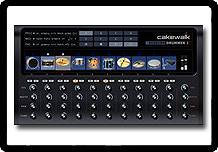
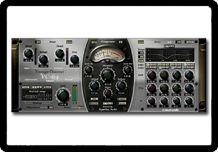
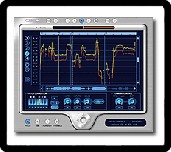
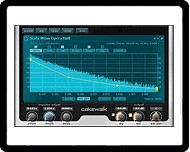
![]()
Producer Edition Plugins
(Session Drummer 2, Vintage Channel 64, Roland V-Vocal, Perfect Space Convolution Reverb,
Lexicon Pantheon Reverb)
I've mentioned the Producer Edition a few times now, but without going into detail as what makes it special. It's tempting to say that the main difference between it and the Studio edition are the featured plugins, but that wouldn't be fair because the ability to mix in surround is a major feature all by itself. Plus the POW-r dithering algorithm, called "best in the world" by mastering guru Bob Katz, is of great benefit to stereo mixers of all types.
But if you're not mixing for surround, is it worth the extra two hundred bucks? Oh yeah. The V-Vocal plugin alone is worth twice this, if you don't already have it - and if you do already have it, that means you're probably upgrading from SONAR 5 because the last three plugins in the picture above (V-Vocal, & Perfect Space & Pantheon) shipped with that version too. In fact, the Lexicon Pantheon Reverb has been part of the Producer series since SONAR 3 - and that was a big deal, because it was the first time that Lexicon had ever lent its king-of-reverbs name to a software plugin. Which brings up an important point - once a plugin debuts in SONAR, it's there for good. With a few exceptions SONAR 6 Producer Edition comes with every plugin that has ever shipped, meaning that the projects you create today should keep working in SONAR 10 four years from now.
So from the SONAR 6 review point of view, it's the first two plugins that matter - Session Drummer 2, and the Vintage Channel 64. The VC64, written by KJaerhus Audio, is a dual optical compressor/de-esser/EQ/gate with a unique mid-side 'shuffler' functionality that can perform some amazing surgery on your stereo image that I haven't seen anywhere else. Session Drummer 2, on the other hand, is a popular item that should have been included in the Studio Edition because it's a good sounding, easy-to-use & flexible drum module which which to kick the Fruity Loops habit. This is not the first time that Cakewalk has tried to address the drum issue, and while they've provided several different solutions over the years, I always felt that their heart wasn't quite in it. After all, SONAR has always been an excellent MIDI sequencer, and what more do you need than that? Eat your veggies! Session Drummer 2 reminds me of a cross between the Cyclone DXi sampler and the Session Drummer drum generator, streamlined and reincarnated as a beatbox. Use Cakewalk's patterns & samples, or create your own - it's open-ended and you can easily create custom kits from scratch.
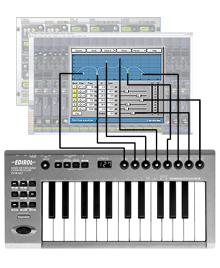
Active Controller Technology (ACT) in action
Alright, I'm gonna have to wrap this review up with a few personal experiences, having lived with SONAR 6 for about a month. First, I want to say that this is the most time I've spent exploring a new product since Cakewalk Pro Audio 5 came out over a decade ago. The new feature list is huge, with practical improvements big and small resulting in an upgrade that greatly exceeded my expectations. And it's also the first upgrade where simply reading the "What's New" section of the manual is not enough as the printed docs have shrunk and a number of features go unmentioned. My favorite addition is AudioSnap, but there are many less-flashy enhancements that rock such as the brilliantly enhanced ACT plugin automation, SMPTE time-locked clip placement, 64-bit file export, the new Plugin Organizer, Clip Locking, dual CPU meters, Spectrum Analyzer, friendly device naming and all the Customize-Anything-You-Damn-Well-Please (CAYDWP) user interface enhancements. Upgrading SONAR users may feel a bit of shock for the first week or two, but that wears off once you get past the new eye candy because most aspects of workflow are unchanged (or can be configured to be!) from prior versions.
Team Warriors Note: SONAR 6 can read the files of all previous versions along with OMF, and the versions from SONAR 3 on are largely file compatible in both directions. And it's still dongle-free, so there's nothing preventing you from running SONAR on both your desktop and your laptop. For more info, please visit: http://cakewalk.com/Products/SONAR/default.asp. Excelsior!
-djh